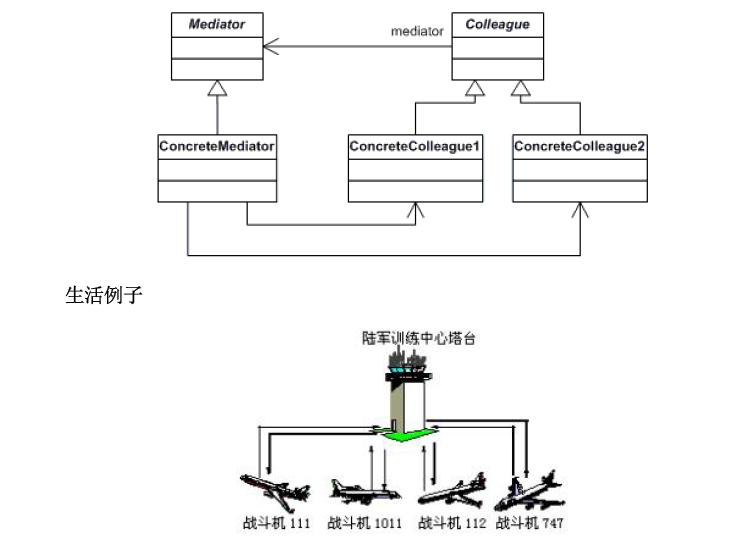|
依赖关系的转化:

动机(Motivate):
在软件构建过程中,经常会出现多个对象互相关联交互的情况,对象之间常常会维持一种复杂的引用关系,如果遇到一些需求的更改,这种直接的引用关系将面临不断的变化。
在这种情况下,我们可使用一个“中介对象”来管理对象间的关联关系,避免相互交互的对象之间的紧耦合引用关系,从而更好地抵御变化。
意图(Intent):
用一个中介对象来封装一系列对象交互。中介者使各对象不需要相互引用,从而使其耦合松散,而且可以独立地改变它们之间的交互。
------《设计模式》GOF
结构图(Struct):

适用性:
1.一组对象以定义良好但是复杂的方式进行通信。产生的相互依赖关系结构混乱且难以理解。
2.一个对象引用其他很多对象并且直接与这些对象通信,导致难以复用该对象。
3.想定制一个分布在多个类中的行为,而又不想生成太多的子类。
代码实现:
1 //Mediator
2 abstract class AbstractChatroom
3 {
4 public abstract void Register(Participant participant);
5 public abstract void Send(string from, string
to, string message);
6 } |
1 //ConcreteMediator
2 class Chatroom :AbstractChatroom
3 {
4 private Hashtable participants = new Hashtable();
5 public override void Register(Participant participant)
6 {
7 if (participants[participant.Name] == null)
8 {
9 participants[participant.Name]=participant;
10 }
11 participant.Chatroom = this;
12 }
13 public override void Send(string from, string
to, string message)
14 {
15 Participant pto = (Participant)participants[to];
16 if (pto != null)
17 {
18 pto.Receive(from, message);
19 }
20 }
21 } |
1 //AbstractColleague
2 class Participant
3 {
4 private Chatroom chatroom;
5 private string name;
6
7 //Constructor
8 public Participant(string name)
9 {
10 this.name = name;
11 }
12 //Properties
13 public string Name
14 {
15 get { return name; }
16 }
17 public Chatroom Chatroom
18 {
19 set { chatroom = value; }
20 get { return chatroom; }
21
22 }
23 public void Send(string to, string message)
24 {
25 chatroom.Send(name, to, message);
26 }
27 public virtual void Receive(string from, string
message)
28 {
29 Console.WriteLine("{0} to {1}:'{2}'",
from, name, message);
30 }
31 } |
1 //ConcreteColleaguel
2 class Beatle :Participant
3 {
4 //Constructor
5 public Beatle(string name)
6 : base(name)
7 { }
8 public override void Receive(string from, string
message)
9 {
10 Console.Write("To a Beatle: ");
11 base.Receive(from, message);
12 }
13 } |
1 //ConcreteColleague2
2 class NonBeatle :Participant
3 {
4 //Constructor
5 public NonBeatle(string name)
6 : base(name)
7 { }
8 public override void Receive(string from, string
message)
9 {
10 Console.Write("To a non-Beatle:");
11 base.Receive(from, message);
12 }
13 } |
客户端调用如下:
1 static void Main(string[]
args)
2 {
3 //create chatroom
4 Chatroom chatroom = new Chatroom();
5 //Create participants and register them
6 Participant George = new Beatle("George");
7 Participant Paul = new Beatle("Paul");
8 Participant Ringo = new Beatle("Ringo");
9 Participant John = new Beatle("John");
10 Participant Yoko = new Beatle("Yoko");
11 chatroom.Register(George);
12 chatroom.Register(Paul);
13 chatroom.Register(Ringo);
14 chatroom.Register(John);
15 chatroom.Register(Yoko);
16
17 //chatting participants
18 Yoko.Send("John", "Hi John");
19 Paul.Send("Ringo", "All you need
is love");
20 Ringo.Send("George", "My sweet
Lord");
21 Paul.Send("John", "Can't buy me
love");
22 John.Send("Yoko", "My sweet love");
23 } |
运行结果如下:

Mediator实现要点:
1.将多个对象间复杂的关联关系解耦,Mediator模式将多个对象间的控制逻辑进行集中管理,变“多个对象互相关系”为多“个对象和一个中介者关联”,简化了系统的维护,抵御了可能的变化。
2.随着控制逻辑的复杂化,Mediator具体对象的实现可能相当复杂。 这时候可以对Mediator对象进行分解处理。
3.Facade模式是解耦系统外到系统内(单向)的对象关系关系;Mediator模式是解耦系统内各个对象之间(双向)的关联关系。
|